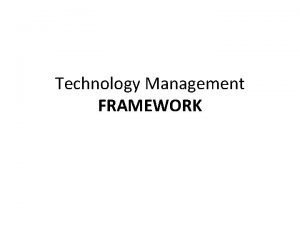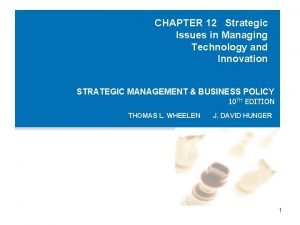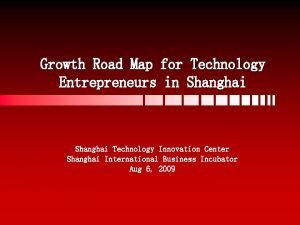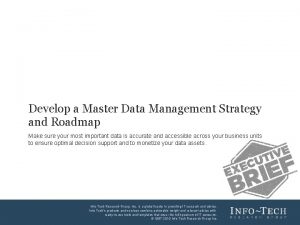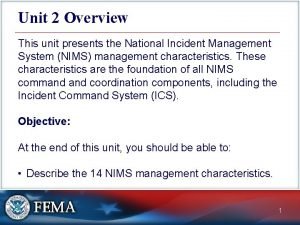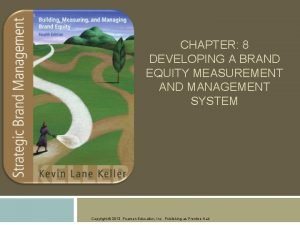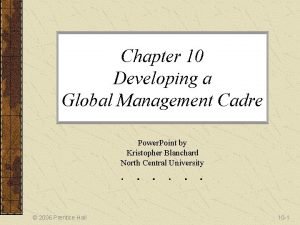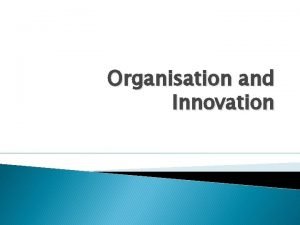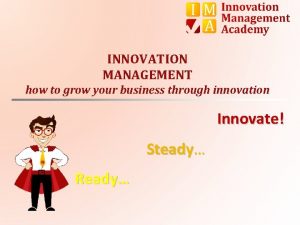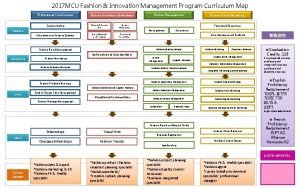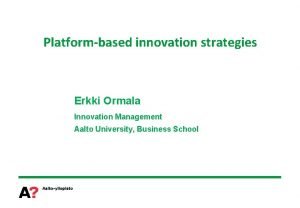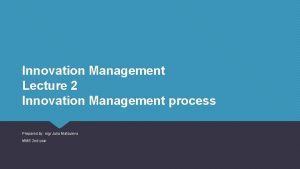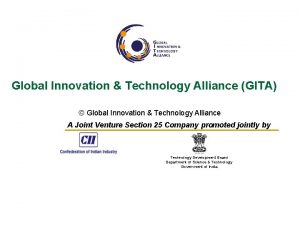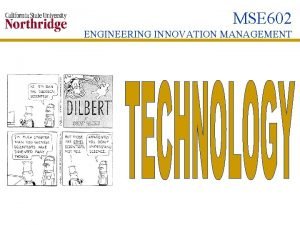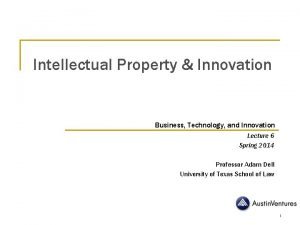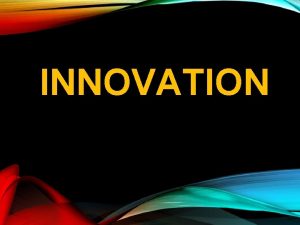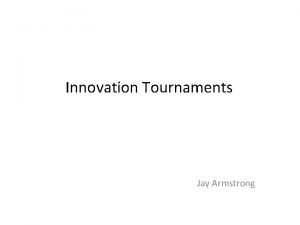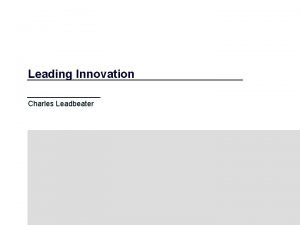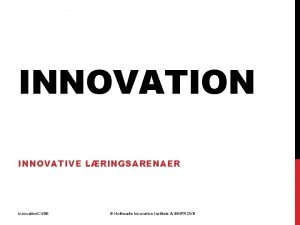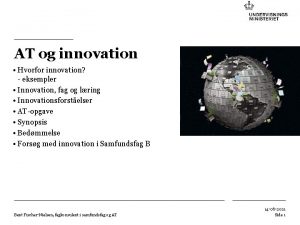INNOVATION TECHNOLOGY MANAGEMENT LECTURE 4 DEVELOPING THE FRAMEWORK

















- Slides: 17

INNOVATION & TECHNOLOGY MANAGEMENT LECTURE 4: DEVELOPING THE FRAMEWORK FOR AN INNOVATION STRATEGY 1

BACKGROUND “ Innovation plays an important and dual role, as both a major source of uncertainty and change in the environment, and a major competitive resource within the firm. In this chapter, we develop what is considered to be the Most useful framework for defining and implementing corporate innovation strategy”

SCOPE Review of : • ‘ Rationalist ‘ VS ‘Incrementalist’ approaches to technological innovation • Michael Porter’s Framework • David Teece and Gary Pisano Framework

RATIONALIST APPROACH ‘Military’ style • Strategy : Evaluate (1) Describe, understand analyze environment Tool : SWOT Analysis The analysis of corporate Strengths and Weaknesses in the light of external Opportunities and Threats Determine Act (2) Determine course of action in light of analysis (3) Carry out the decided course of action.

RATIONALIST APPROACH • • • Advantages : Know company’s competitive advantages Aware of trends in the competitive environment. Prepared for a changing future Align whole organization with its objectives Analyze prospects for sales and profitability Allow for the development of contingency plans Disadvantages : Rigid Too much focus on elimination of competition Analysis not completely accurate

RATIONALIST APPROACH – HISTORY OF FAILURES 1960 s • Event : Oil company Gulf defined its “Strength” as producing energy, acquired a Nuclear energy firm • Diagnosis : Inaccurate identification of scope of strength Actual strength is in finding, extracting, refining and distributing oil-based products ( i. e. geology and chemical processing technologies, logistics, consumer marketing) which were largely irrelevant to the design, construction and sale of nuclear reactors, where the key skills are in electromechanical technologies and in selling to relatively few, but often politicized electrical utilities 1960 s & 70 s • Event : Firms in the electrical industry bet heavily in future of Nuclear energy as revolutionary breakthrough that will provide costless energy • Diagnosis : Inaccurate identification of opportunities & threats, wrong timing Nuclear energy failed to fulfill its promise, and firms only recognized later that the main revolutionary opportunities and threats for them came from the virtually costless storage and manipulation of information provided by improvements in semiconductor and related technologies.

RATIONALIST APPROACH – HISTORY OF FAILURES 1980 s • Event : Analysts and practitioners predicted convergence of computer and communications technologies through digitalization (i. e. Vo. IP using Skype, Digital / Internet Phone ) • Diagnosis : Unfamiliarity with the technology and market Many firms tried to diversify other markets, often through acquisitions or alliances, e. g. IBM bought Rohm, AT&T bought NCR. Most proved unsuccessful, in part because the software requirements in the telecommunications and office markets were so different 1990 s • Event : Commitments in the fast-moving fields of ICT (information and communication technology) • Diagnosis : Unfamiliarity with the technology and market; a misjudged assessment own position; lack of awareness own activities within the group. The investments of major media companies in the Internet in the late 1990 s took more than a decade to prove profitable: problems remain in delivering products to consumers and in getting paid for them, and advertising remains ineffective. There have been similar disappointments so far in development and commercialization of ‘e-entertainment’.

RATIONALIST APPROACH – HISTORY OF FAILURES 1990 s • Event : The Internet Bubble - wildly optimistic and unrealistic valuations on new ventures utilizing e-commerce. “ Everyone with a website was set to become an instant Billionaire” • Diagnosis : Opportunities without risk assessment • Burst by 2000 • Companies sprouting up were overvalued • In particular, most of the new e-commerce businesses selling to consumers which floated on the US and UK stock exchanges between 1998 and 2000 subsequently lost around 90% of their value, or were made bankrupt. Notorious failures of that period include Boo. com in the UK, which attempted to sell sports clothing via the Internet, and Pets. com in the USA, which attempted to sell pet food and accessories. 2000 s

“INCREMENTALIST” APPROACH • ‘Trial and Error’ style “Complete understanding of complexity and change is impossible: our ability both to comprehend the present and to predict the future is therefore inevitably limited……which explicitly recognizes that the firm has only very imperfect knowledge of its environment, of its own strengths and weaknesses, and of the likely rates and directions of change in the future. It must therefore be ready to adapt its strategy in the light of new information and understanding, which it must consciously seek to obtain. ” • Strategy : (1) Make deliberate steps / changes towards the stated objective. (2) Measure and evaluate the effects of the steps / changes. (3) Adjust (if necessary) the objective and decide on the next step/change. In context of medical doctors dealing with patients : Symptom Diagnosis Treatment Diagnosis Adjust Treatment Cure

“RATIONALIST” VS “INCREMENTALIST” • Implications : In view of complex, uncertain environment : “ Incrementalist strategies are more rational and efficient than rationalist strategies”. “ Corporate strategy, which should be seen as a form of corporate learning, from analysis and experience, how to cope more effectively with complexity and change. ” “Successful management practice is never fully reproducible”

MICHAEL PORTER’S FRAMEWORK 5 Forces Driving Industry Competition : • Relations with suppliers. • Relations with buyers. • New entrants. • Substitute products. • Rivalry amongst established firms. Michael Porter : “The goal of competitive strategy. . . is to find a position in an industry where a company can best defend itself against these competitive forces or can influence them in its favor’. Technological change can influence all the five forces.

MICHAEL PORTER’S FRAMEWORK • Market Strategies “ To be profitable focus on 1, Select more than 1, incurs low profits”

MICHAEL PORTER’S FRAMEWORK • Market Strategies : Michael Porter : “ Choose 1” • Innovation ‘leadership’ – • where firms aim at being first to market, based on technological leadership. • Involves creativity and risk-taking, with close linkages both to major sources of relevant new knowledge, and to the needs and responses of customers. • Innovation ‘followership’ – • where firms aim at being late to market, based on imitating (learning) from the experience of technological leaders. • Involves competitor analysis and intelligence, to reverse engineering and to cost cutting and learning in manufacturing. Michael Porter : “Innovation strategy should aim to repel competitive threats, both from incumbents in the industry and potential new entrants, including new and substitute products based on new technological opportunities. ”

Michael Porter’s Framework Weakness Case study : Computer Industry 1970 s • Few Mainframe producers • High barriers to entry • Suppliers are weak • Customer has limited choices Technological Breakthrough in Microprocessor • Reduced cost of computing • Lowers barriers to entry 1990 s • Increase in new entrants • New opportunities and applications • Customer spoilt for choice IBM, an (established and technological advanced firm ) was aware of trends but still unable to “ find a position … defend itself against competitive forces or influence them in its favor.

Michael Porter’s Framework Main Critics : • underestimates the power of technological change to transform industrial structures underestimates the importance of technological trajectories, and of the firm specific technological and organizational competencies to exploit them. •

David Teese & Gary Pisano Framework “Dynamic Capabilities” Approach 1. It refers to the shifting character of the environment 2. It emphasizes the key role of strategic management in appropriately adapting, integrating and re-configuring internal and external organizational skills, resources and functional competencies towards a changing environment

David Teese & Gary Pisano Framework “Dynamic Capabilities” Approach • Strategy : Firm’s Capability : • Improved / perfected to meet a user need • Unique • Difficult to replicate Strategic dimensions of the firm are its: § Managerial and organizational processes its ‘routines’, or patterns of current practice and learning § Its present position current endowment of technology and intellectual property, its customer base and upstream relations with suppliers • Paths available to it strategic alternatives available to the firm, and the attractiveness of the opportunities which lie ahead
 Innovation for the sake of innovation
Innovation for the sake of innovation Radical innovation vs disruptive innovation
Radical innovation vs disruptive innovation 01:640:244 lecture notes - lecture 15: plat, idah, farad
01:640:244 lecture notes - lecture 15: plat, idah, farad Gregory framework
Gregory framework Technology business management (tbm)
Technology business management (tbm) Strategic issues in managing technology and innovation
Strategic issues in managing technology and innovation Shanghai technology innovation center
Shanghai technology innovation center Develop a master data management strategy and roadmap
Develop a master data management strategy and roadmap To avoid overburdening the incident command resources
To avoid overburdening the incident command resources Brand equity charter
Brand equity charter Developing a global management cadre
Developing a global management cadre Slack
Slack Oracle product lifecycle management
Oracle product lifecycle management Imitator pathfinder
Imitator pathfinder Fashion and innovation management
Fashion and innovation management New innovation management ab
New innovation management ab Rasberry
Rasberry Erkki ormala
Erkki ormala



